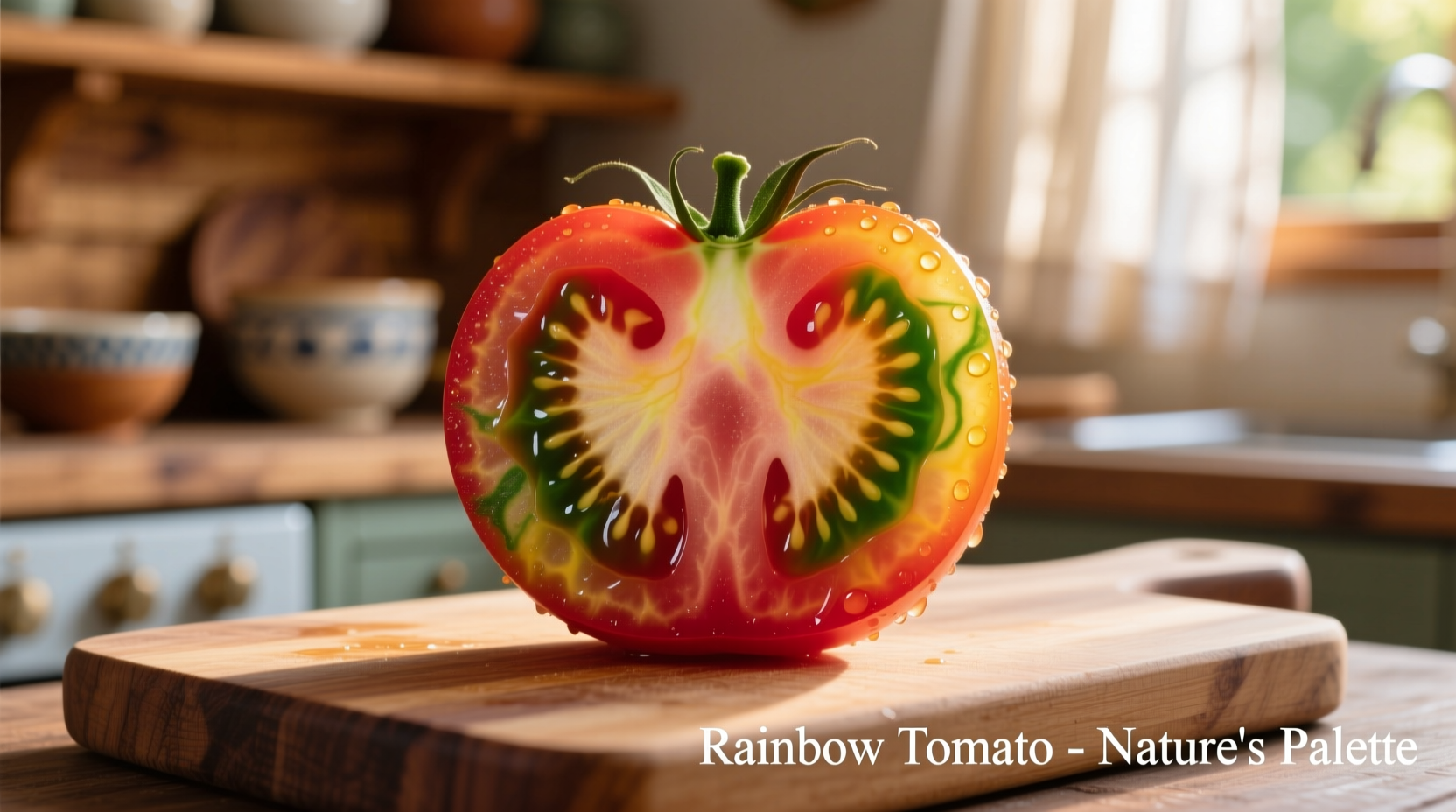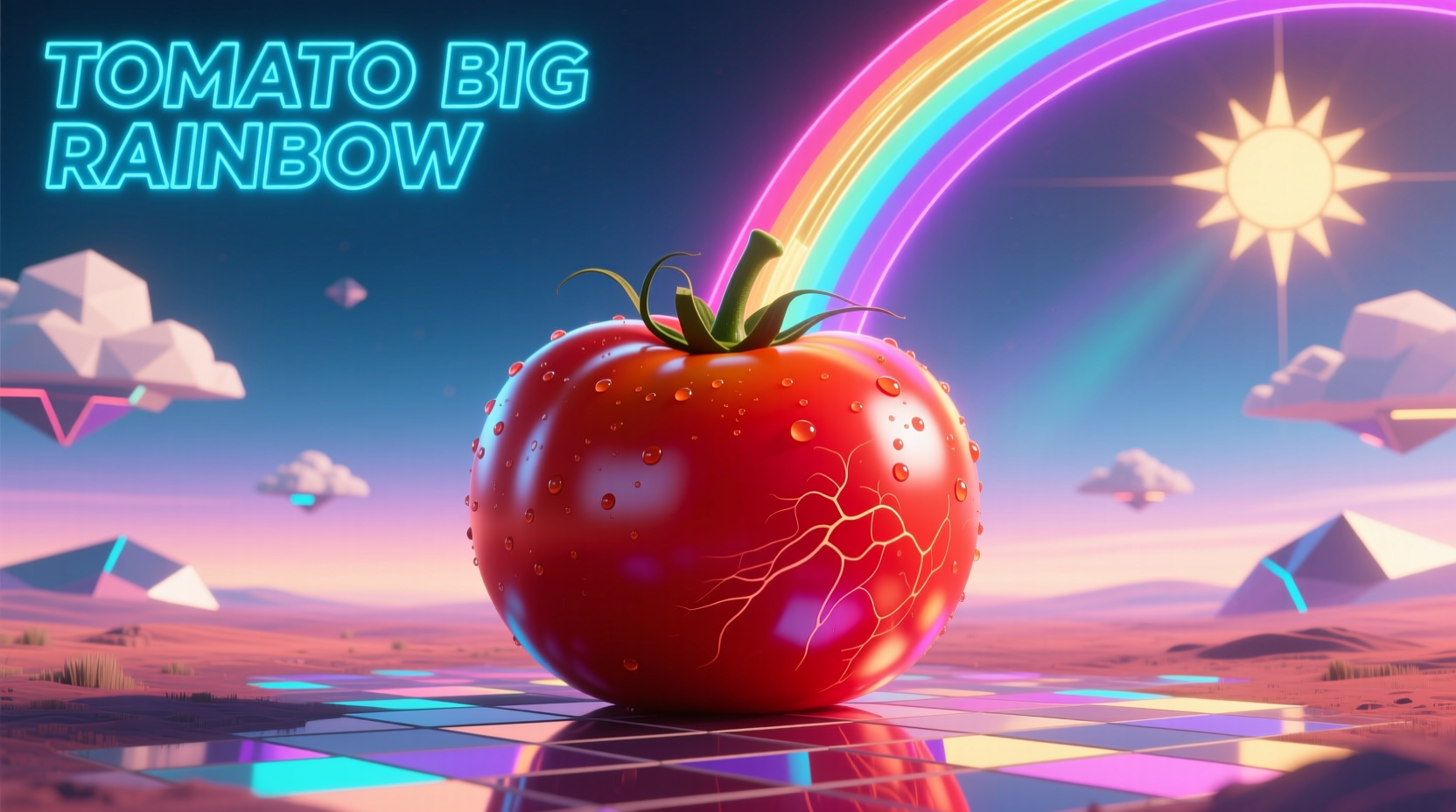Big Rainbow tomatoes deliver exceptional flavor with their striking marbled appearance—yellow-orange flesh streaked with red. These large beefsteak heirlooms typically weigh 1-2 pounds, mature in 75-85 days, and offer a complex sweet-tart taste perfect for slicing, salads, and fresh sauces. This complete guide covers everything you need to successfully grow, harvest, and use these visually stunning tomatoes.
What Exactly Is a Big Rainbow Tomato?
Big Rainbow represents one of the most visually distinctive heirloom tomato varieties available to home gardeners today. This beefsteak-type tomato features a unique color pattern—yellow or orange base flesh marbled with red streaks that create a "rainbow" effect when sliced. Unlike many modern hybrids, Big Rainbow maintains the complex flavor profile that heirloom enthusiasts seek.
Developed through careful selection of heritage varieties, Big Rainbow tomatoes typically reach impressive sizes of 1-2 pounds each. The plants grow as indeterminate vines, meaning they continue producing fruit throughout the growing season until frost. Their distinctive appearance makes them conversation starters at farmers' markets and garden tours alike.
Historical Development Timeline
Understanding the evolution of Big Rainbow tomatoes helps appreciate their significance in modern gardening:
| Time Period | Development Milestone | Significance |
|---|---|---|
| Early 1900s | Initial development of multicolored heirloom varieties | Foundation varieties like "Aunt Ruby's German Green" emerged |
| 1980s-1990s | Specialized breeding for color intensity and flavor balance | Seed savers organizations documented and preserved rare varieties |
| Early 2000s | "Big Rainbow" name standardized among seed companies | Recognition by Seed Savers Exchange and specialty seed catalogs |
| 2010-Present | Increased popularity among home gardeners and farmers' markets | Ranked among top 20 heirloom varieties by University extension programs |
Physical Characteristics and Flavor Profile
Big Rainbow tomatoes stand out with their distinctive appearance and complex flavor. When sliced, they reveal a beautiful gradient from yellow-orange at the exterior to deep red marbling toward the center. This visual appeal doesn't come at the expense of taste—the variety delivers a remarkably balanced flavor profile that combines sweetness with subtle acidity.
According to sensory evaluations conducted by the University of California Cooperative Extension, Big Rainbow tomatoes score highly for:
- Sweetness: Brix levels typically range from 6.5-7.5, higher than many standard red varieties
- Acidity: Balanced pH around 4.3-4.5 creates that signature sweet-tart complexity
- Texture: Meaty yet juicy interior with minimal seed cavities
- Aroma: Distinctive fruity fragrance with citrus undertones

Growing Big Rainbow Tomatoes Successfully
While Big Rainbow tomatoes reward gardeners with exceptional fruit, they require specific growing conditions to reach their full potential. Unlike some disease-resistant hybrids, heirlooms like Big Rainbow need more attentive care but deliver superior flavor in return.
Essential Growing Requirements
For optimal results with Big Rainbow tomatoes, follow these evidence-based recommendations from agricultural extension services:
- Planting time: Start seeds indoors 6-8 weeks before last frost date; transplant outdoors when soil reaches 60°F (15.5°C)
- Spacing: Allow 24-36 inches between plants with 4-5 feet between rows for proper air circulation
- Sun exposure: Minimum 8 hours of direct sunlight daily (10+ hours preferred)
- Soil requirements: Well-draining soil with pH 6.2-6.8 and high organic matter content
- Watering: Consistent moisture (1-2 inches weekly), avoiding wetting foliage to prevent disease
Regional Growing Considerations
Big Rainbow tomatoes perform differently depending on your climate zone. Research from Cornell University's vegetable program shows these regional adaptations:
- Cooler climates (USDA zones 3-5): Start seeds indoors 8-10 weeks before last frost; use black plastic mulch to warm soil; select early-maturing plants
- Moderate climates (zones 6-7): Direct seed after soil warms or transplant at standard timing; provide afternoon shade in hot summers
- Warmer climates (zones 8-10): Plant as a fall crop; provide morning sun with afternoon shade; select heat-tolerant companion varieties
Notably, Big Rainbow tomatoes show reduced fruit set when temperatures consistently exceed 90°F (32°C), making them less suitable for extremely hot regions without careful microclimate management.
Harvesting and Storage Techniques
Timing your Big Rainbow tomato harvest correctly ensures peak flavor and texture. Unlike commercial varieties bred for firmness, heirlooms like Big Rainbow develop their best flavor when allowed to ripen fully on the vine.
Watch for these visual indicators that Big Rainbow tomatoes are ready for harvest:
- Base color shifts from green to yellow-orange
- Red marbling becomes more pronounced throughout the fruit
- Fruit yields slightly to gentle palm pressure
- Characteristic fruity aroma develops
For best storage results, follow these research-backed methods from the USDA Agricultural Research Service:
- Store at room temperature (60-70°F) away from direct sunlight
- Never refrigerate whole tomatoes as cold temperatures destroy flavor compounds
- Use within 3-5 days of peak ripeness for best quality
- If preserving excess harvest, freeze sliced tomatoes for sauces (do not water-bath can heirlooms without proper acidification)
Culinary Applications and Recipe Ideas
Big Rainbow tomatoes shine in preparations that showcase their visual appeal and complex flavor. Their balanced sweetness and acidity make them versatile across numerous culinary applications.
Professional chefs and home cooks consistently rate Big Rainbow tomatoes highest for:
- Fresh preparations: Caprese salads, tomato sandwiches, bruschetta
- Sauces: Fresh tomato sauces where color contrast adds visual interest
- Salsas: The natural sweetness balances spicy peppers beautifully
- Presentation: Sliced for garnishes where the marbled interior creates visual drama
When developing recipes with Big Rainbow tomatoes, remember their higher moisture content compared to some commercial varieties. For thicker sauces, consider removing excess gel and seeds before cooking. Their natural pectin content helps sauces thicken beautifully with minimal cooking time.
Troubleshooting Common Growing Challenges
Like all heirloom tomatoes, Big Rainbow varieties face specific challenges that require proactive management:
- Blossom end rot: Prevent with consistent watering and calcium supplementation (apply gypsum at planting)
- Cracking: Avoid irregular watering patterns; harvest slightly early during heavy rain periods
- Fungal diseases: Implement strict crop rotation (3-4 years between tomato plantings); use drip irrigation to keep foliage dry
- Bird damage: Cover ripening fruit with netting; harvest at breaker stage and finish ripening indoors
According to integrated pest management guidelines from land-grant universities, Big Rainbow tomatoes show moderate susceptibility to common tomato diseases but generally outperform many heirlooms in field performance when given proper cultural care.











 浙公网安备
33010002000092号
浙公网安备
33010002000092号 浙B2-20120091-4
浙B2-20120091-4